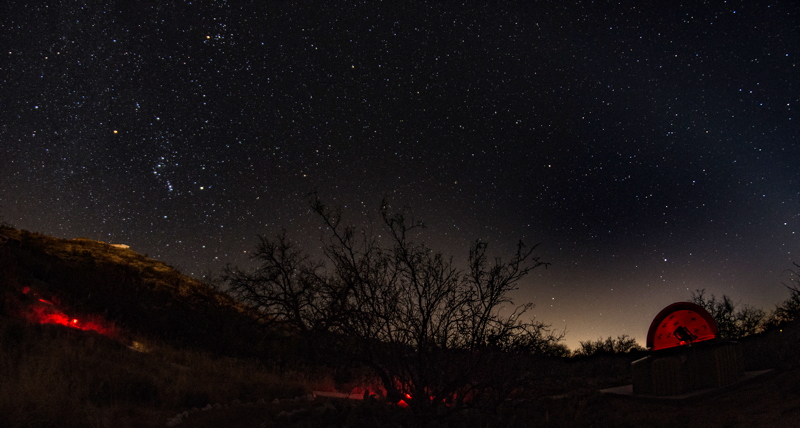DSLR Imaging: Orion, Zodiacal Light,
Asteroid Edmondson attempt
Posted: 12 January 2018
After being clear during the day on Friday, 5 January 2018, clouds rapidly came in as sunset approached, beginning another long period of cloudy skies.
Sunday morning, 7 January, I woke up early to try to see the close conjunction of Mars and Jupiter. The planets were briefly visible through a small hole in the cloud cover. I went outside to try to photograph it, but by the time I got outside the small hole was gone and I only got a brief dim glimpse of the two planets through the clouds. I did get this handheld photo of the near Last Quarter Moon and the clouds with the D7200 DSLR, f/6, 1/30sec, ISO 1600. FL 350mm:

I waited about 30 minutes in case the planets appeared; they did not so I was unable to photograph the close conjunction.
Tuesday night, 9 January, there was a brief thundershower (0.13" rain) and then another 1.27" on Wednesday, 10 January. The sky finally cleared on Thursday, 11 January.
|
Open: Thursday, 11 January 2018, 1812 MST Temperature: 60°F |
Session: 1184 Conditions: Clear |
Equipment Used:
12" f/8 LX600 w/StarLock
2" 24mm UWA eyepiece
Focal Reducer
SkyTracker Pro
Camera:
D7200 DSLR
1819 MST: LX600 ON, StarLock OFF, High Precision OFF.
Slewed the 12" telescope to the star Aldebaran and SYNCed the AutoStar. Then began setting up the SkyTracker Pro for sky imaging. As I was doing that I saw (and heard) a Great Horned Owl on the house roof, seen here in this 2X iPhone 8 Plus photo:

I set up the SkyTracker Pro with the D7200 DSLR slightly to the Northeast of the observatory, as seen in this iPhone photo:

1856 MST: took this D7200 DSLR photo (f/5, 30 seconds, ISO 1600, White Balance Auto, FL 8mm fisheye, slightly cropped, 1/2X Sidereal tracking rate) showing the constellations of Orion and Taurus at the left and the observatory at the right:

The Zodiacal Light was visible in the western sky. 1900 MST: I pointed the camera towards it for this D7200 DSLR photo (f/5, 60 seconds, ISO 1600, White Balance Auto, FL 8mm fisheye, slightly cropped, 1/2X Sidereal tracking rate):

The Zodiacal Light is the faint band of light at the center, starting just to the right of the observatory and extending up and to the left towards the top of the photo. A portion of the Milky Way is visible at the far right of the photo.
1920 MST: after returning to the observatory I began setting up to try to image Asteroid (1761) Edmondson. Dr. Frank Edmondson was the Chairman of the Indiana University Astronomy Department when I was an undergraduate student 1966-70. During my four years at IU I worked on the IU Asteroid Program. I thought it would be nice to try to image Asteroid Edmondson, but with its Magnitude +18 it would be a challenge with my DSLR camera. I mounted the DSLR at prime focus + focal reducer. I focused on the star Aldebaran using a Bahtinov Mask. 1928 MST: Wi-Fi ON. Used SkySafari 6 Pro on the iPhone to GOTO Asteroid Edmondson. I then waited about 30 minutes for the StarLock to clear the dome.
2004 MST: StarLock ON. I had set the Guide Rates to RA 10% DEC 11%. Did a test exposure, but was not happy with the tracking. Changed the Guide Rates to RA 65% DEC 66%, which worked out much better. 2010 MST: took this StarLock autoguided, 5 minutes, ISO 6400, White Balance 3570K, image:

If all went well Asteroid Edmondson should be in the image. The galaxy at the top right is IC1723 (Mag +14.02). A smaller fainter galaxy is visible in the center of the image. I will take another image of this same area 24 hours later to check for any apparent motion which would confirm imaging of Asteroid Edmondson.
2016 MST: StarLock OFF, Wi-Fi OFF. Removed the camera from the 12" telescope.
I took a quick look at M41 (open star cluster) and M42 (Great Nebula in Orion), 102X.
2031 MST: LX600 OFF.
|
Close: Thursday, 11 January 2018, 2039 MST Temperature: 49°F |
Session Length: 2h 27m Conditions: Clear, breezy |
Comments are welcome using Email. Twitter users can use the button below to tweet this report to their followers. Thanks.
Cassiopeia Observatory Home Page
Copyright ©2018 Michael L. Weasner / mweasner@me.com
URL = http://www.weasner.com/co/Reports/2018/01/12/index.html
